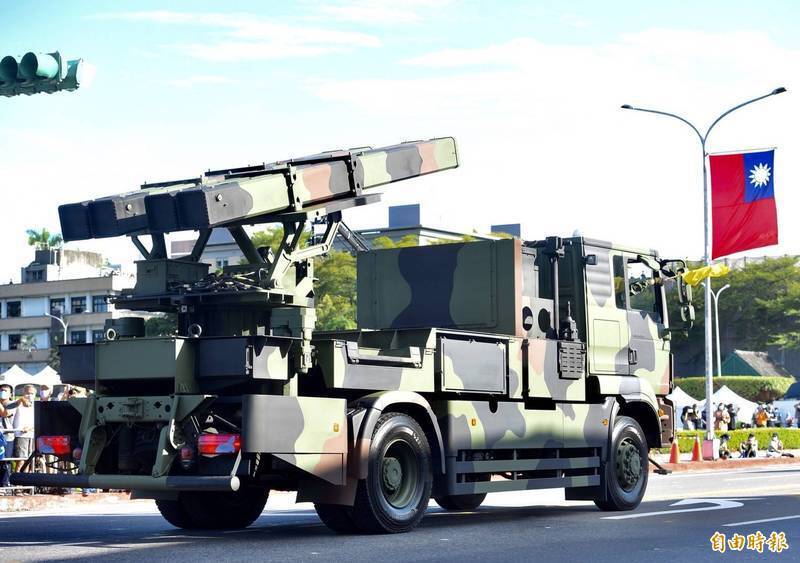According to military sources, the Lu She Jian 2 missile system still has considerable room for research and improvement in the future, and it can refer to the operational flexibility of the NASAMS air defense system.
The picture shows the Lushejian 2 missile vehicle participating in the National Day military display. The vehicle is equipped with 4 Lushejian 2 missiles.
(file photo)
[Reporter Luo Tianbin/Taipei Report] The NASAMS "National Advanced Air Defense System" aided by the United States to Ukraine has been recognized by Ukraine and other countries for its superior performance. A senior military official said today that the biggest feature of NASAMS "National Advanced Air Defense System" is that it can be compared with Air Force fighters Share the US-made AIM-120 and AIM-9X Block II short-to-medium-range missiles. When the airport is paralyzed by attack and the fighter is disabled, it can flexibly convert the inoperable fighter missiles to the air defense system.
He pointed out that in order to optimize Taiwan's investment in air defense and combat capabilities, the Chinese Academy of Sciences is currently mass-producing the Lushejian II missile system. There should be considerable room for improvement in the future. "Advanced Air Defense System" features, so that the Tianjian-2 medium-range air-to-air missiles and Tianjian-1 short-range air-to-air missiles currently used by the IDF fighters of the Air Force can also be equipped with the Land Shejian-2 missile system when necessary .
Please read on...
The land-launched Jian-2 missile system is called "field air defense weapon system" inside the military. It is a complete set of "field air defense weapon system". Composed of bullet cars.
The missile launch vehicle is equipped with 4 land-launched Jian-2 missiles, with an effective range of 15 kilometers and a maximum range of 30 to 45 kilometers. It will become the main force of the army's corps-level air defense force, and priority will be given to the replacement of the existing castor missile system.
The U.S. government aids Ukraine's "National Advanced Air Defense System" (NASAMS). This air defense system combines the MPQ-64 "Sentinel" radar, multiple types of short- and medium-range air defense missiles, and Link 16 military data links. It is a powerful short- and medium-range ground air defense system.
Compatible anti-aircraft missile types include AIM-120 Advanced Medium-Range Air-to-Air Missile (AMRAAM), Enhanced AMRAAM (ER), and short-range AIM-9X Block II "Sidewinder" missile, German Make IRIS-T short-range anti-aircraft missiles, etc., and the anti-aircraft range can reach 40 to 50 kilometers.
According to military personnel, the Ukrainian-Russian War has inspired many countries in military defense and countermeasure warfare. Among them, the NASAMS system can be used flexibly in operations, and the types of ammunition can be used with Air Force fighters to share the US-made AIM-120 and AIM-9X Block II. The short-to-medium-range missiles are an eye-opener for our side, because this flexible approach can flexibly convert non-operational fighters and missiles to the air defense system once the airport is paralyzed by Chinese attacks and the fighters are disabled.
He pointed out that the land-launched Jian-2 missile system is currently being mass-produced by the Chinese Academy of Sciences, but there is still considerable room for improvement and research and improvement. In the future, when upgrading and researching, the characteristics of the NASAMS system should be incorporated into the research and reform. The goal is to make the use of domestic Tianjian missiles more flexible in combat.
U.S. military assistance to Ukraine’s NASAMS "National Advanced Air Defense System" is characterized by the ability to share U.S.-made AIM-120 and AIM-9X Block II short- and medium-range missiles with Air Force fighter jets. When the airport is paralyzed by attack and the fighter jet is disabled, flexible conversion cannot Operational fighter missiles for air defense systems.
(Picture: Taken from the official website of the Norwegian Ministry of Defense)
